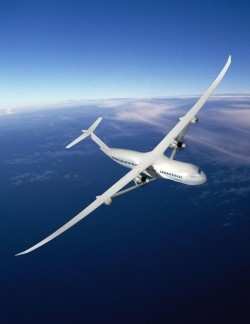Wed, Jan 09, 2013
Eight Demonstration Concepts Focus On Five Areas To Improve Airliner Efficiency
NASA has selected eight large-scale integrated technology demonstrations to advance aircraft concepts and technologies that will reduce the impact of aviation on the environment over the next 30 years, research efforts that promise future travelers will fly in quieter, greener and more fuel-efficient airliners.

The demonstrations, which are part of NASA's Environmentally Responsible Aviation (ERA) Project, will focus on five areas -- aircraft drag reduction through innovative flow control concepts, weight reduction from advanced composite materials, fuel and noise reduction from advanced engines, emissions reductions from improved engine combustors, and fuel consumption and community noise reduction through innovative airframe and engine integration designs.
The selected demonstrations are:
- Active Flow Control Enhanced Vertical Tail Flight Experiment: Tests of technology that can manipulate, on demand, the air that flows over a full-scale commercial aircraft tail.
- Damage Arresting Composite Demonstration: Assessment of a low-weight, damage-tolerant, stitched composite structural concept, resulting in a 25 percent reduction in weight over state-of-the-art aircraft composite applications.
- Adaptive Compliant Trailing Edge Flight Experiment: Demonstration of a non-rigid wing flap to establish its airworthiness in the flight environment.
- Highly Loaded Front Block Compressor Demonstration: Tests to show Ultra High Bypass (UHB) or advanced turbofan efficiency improvements of a two-stage, transonic high-pressure engine compressor.
- 2nd Generation UHB Ratio Propulsor Integration: Continued development of a geared turbofan engine to help reduce fuel consumption and noise.
- Low Nitrogen Oxide Fuel Flexible Engine Combustor Integration: Demonstration of a full ring-shaped engine combustor that produces very low emissions.
- Flap and Landing Gear Noise Reduction Flight Experiment: Analysis, wind tunnel and flight tests to design quieter flaps and landing gear without performance or weight penalties.
- UHB Engine Integration for a Hybrid Wing Body: Verification of power plant and airframe integration concepts that will allow fuel consumption reductions in excess of 50 percent while reducing noise on the ground.

"With these demonstrations we will take what we've learned and move from the laboratory to more flight and ground technology tests," said Fay Collier, ERA project manager based at NASA's Langley Research Center in Hampton, VA. "We have made a lot of progress in our research toward very quiet aircraft with low carbon footprints. But the real challenge is to integrate ideas and pieces together to make an even larger improvement. Our next steps will help us work towards that goal."
The Environmentally Responsible Aviation Project was created in 2009 and is part of NASA's Aeronautics Research Mission Directorate's Integrated Systems Research Program. During its first phase, engineers assessed dozens of broad areas of environmentally friendly aircraft technologies and then matured the most promising ones to the point that they can be tested together in a real world environment in the second phase. Those experiments included nonstick coatings for low-drag wing designs, laboratory testing of a new composite manufacturing technique, advanced engine testing, and test flights of a remotely piloted hybrid wing body prototype.
Each of the demonstrations, which are scheduled to begin this year and continue through 2015, is expected to include selected industry partners, many of which will contribute their own funding. "ERA's research portfolio provides a healthy balance of industry and government partnerships working collaboratively to mature key technologies addressing ERA's aggressive fuel burn, noise and emission reductions goals for tomorrow's transport aircraft," said Ed Waggoner, director of the Integrated Systems Research Program.
More News
Aero Linx: International Flying Farmers IFF is a not-for-profit organization started in 1944 by farmers who were also private pilots. We have members all across the United States a>[...]
From 2017 (YouTube Version): Remembrances Of An Israeli Air Force Test Pilot Early in 2016, ANN contributor Maxine Scheer traveled to Israel, where she had the opportunity to sit d>[...]
"We renegotiated what our debt restructuring is on a lot of our debts, mostly with the family. Those debts are going to be converted into equity..." Source: Excerpts from a short v>[...]
Also: B-29 Superfortress Reunion, FAA Wants Controllers, Spirit Airlines Pulls Back, Gogo Galileo Van's Aircraft posted a short video recapping the goings-on around their reorganiz>[...]
Chart Supplement US A flight information publication designed for use with appropriate IFR or VFR charts which contains data on all airports, seaplane bases, and heliports open to >[...]
 ANN's Daily Aero-Linx (04.15.24)
ANN's Daily Aero-Linx (04.15.24) Classic Aero-TV: 'No Other Options' -- The Israeli Air Force's Danny Shapira
Classic Aero-TV: 'No Other Options' -- The Israeli Air Force's Danny Shapira Aero-News: Quote of the Day (04.15.24)
Aero-News: Quote of the Day (04.15.24) Airborne 04.16.24: RV Update, Affordable Flying Expo, Diamond Lil
Airborne 04.16.24: RV Update, Affordable Flying Expo, Diamond Lil ANN's Daily Aero-Term (04.16.24): Chart Supplement US
ANN's Daily Aero-Term (04.16.24): Chart Supplement US




